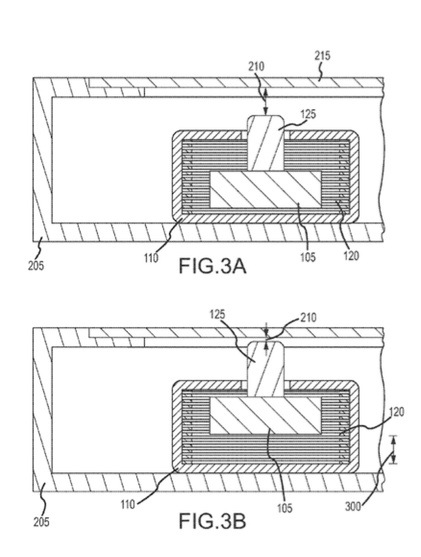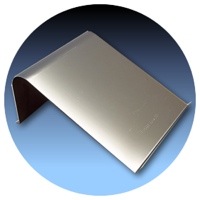Two new Apple patents show that the company is investigating further haptic feedback and electronic percussion input methods for its devices.
Patent number 20120223824 is for a linear vibrator providing localized haptic feedback. The invention involves an apparatus for providing haptic feedback, including: a shell defining an aperture; a driver disposed within the shell; a mass disposed within the coil; and a projection connected to the mass and extending through the aperture. Also described is a method for providing generalized and localized haptic feedback, including the operations of: receiving an input signal; determining if the input signal corresponds to a generalized haptic feedback; if so, providing a first input to a linear vibrator; otherwise, providing a second input to a linear vibrator; wherein the linear vibrator outputs a generalized haptic feedback in response to the first input; and the linear vibrator outputs a localized haptic feedback in response to the second input.
Here’s Apple’s background of the invention: “Many electronic devices use linear vibrators to provide generalized haptic feedback by shaking or vibrating the device enclosure. For example, many mobile telephones may be set to a vibrate mode, so that the phone body (e.g., enclosure) vibrates when a call is received in lieu of emitting an audible ring tone. However, linear vibrators typically vibrate the entire device and/or enclosure and thus provide generalized haptic feedback.
“In certain embodiments, it may be useful or desirable to localize haptic feedback. For example, certain electronic devices may use virtual or touch-based keyboards, buttons, and other input mechanisms. Without some form of localized feedback, it may be difficult for a user to detect if the input mechanism was properly or adequately touched. A generalized haptic feedback, such as vibrating the entire electronic device, may be insufficiently precise.”
Fletcher Rothkopf is the inventor.
Patent number 20120223891 involves methods, computer program products, and systems for receiving gestures and producing percussion instrument signals are disclosed. An exemplary method includes receiving a gesture on an area of a touchscreen representing a percussion instrument and generating a signal based on the gesture and area.
The gesture can be a single point initiation touch on an area, and a drag into another area. The gesture can be a two-touch point initiation touch on a first area, and a change in distance between the points to change a first parameter such as repeat rate. Such gestures can further include translation of the touch points as a group along an axis to change a second parameter such as volume, pitch, or reverb.
Here’s Apple’s background on the invention: “Dedicated electronic percussion instruments, e.g., electronic drums, having a drum pad are known. An electronic drum is a percussion instrument in which the sound is generated by an electronic waveform generator or sampler instead of by acoustic vibration. Typically, when an electronic drum pad is struck (i.e., triggered), a voltage change is caused in an embedded piezoelectric transducer (piezo) or force sensitive resistor (FSR).
“The resultant signals are translated into digital waveforms, which produce the desired percussion sound assigned to that particular trigger pad. Most newer drum modules have trigger inputs for 2 or more cymbals, a kick, 3-4 toms, a dual-zone snare (head and rim), and a hi-hat. The hi-hat has a foot controller which produces open and closed sounds with some models offering variations in-between.
“Percussion instrument functionality can be implemented on devices having a touchscreen, but without a dedicated drum pad. Examples of such devices include tablet computers and smart phones. However, the touchscreen of such devices are typically “on/off” and not velocity sensitive like most drum pads in dedicated electronic percussion instruments. This may inhibit the range of expression of such devices to less than that of acoustic drums or dedicated electronic percussion instruments.
“Also, touchscreen electronic percussion instruments typically do not take advantage of some of the characteristics of dedicated electronic percussion instruments. Further, the limited user interface space typically available in touchscreen devices limits the number of controls that can be offered concurrently. A need exists to provide gesture interfaces for percussion instrument functionality implemented on devices having a touchscreen interface, but no drum pad, and a limited touch surface area.”
Daniel P. Patterson is the inventor.
Also appearing today at the U.S. Patent & Trademark Office:
° Patent number 20120224434 is for systems and methods, including computer software for performing operations enable interleaving of charging operations in a charging pump.
° Patent number 20120223959 is for systems, methods, and non-transitory computer-readable storage media for controlling a slider on a touch-screen.
° Patent number 20120224390 is for a thin-profile portable electronic device with a display is described. The display can include a display assembly with an integrally formed light pipe and perimeter chassis. The light pipe can be utilized to provide back-lighting for the display.
° Patent number 20120224425 is for using temperature sensors with a memory device.
° Patent number 20120224434 is for systems and methods, including computer software for performing operations enable interleaving of charging operations in a charging pump.
° Patent number 20120226370 is for systems, methods, and non-transitory computer-readable storage media for allowing independent control of a formant position and inharmonic content in sound synthesis.
° Patent number 20120226744 is for a method and apparatus for updating and synchronizing information between a client and server.
° Patent number 20120226977 is for systems, methods, and non-transitory computer-readable storage media for controlling a user interface.





